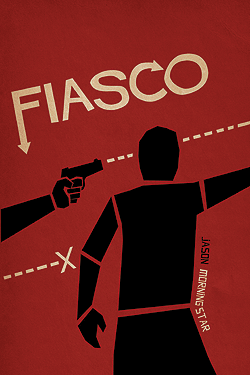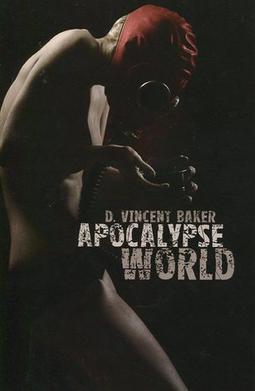
Everway is a fantasy role-playing game first published by Wizards of the Coast under their Alter Ego brand in 1995. Its lead designer was Jonathan Tweet. Marketed as a "Visionary Roleplaying Game", it has often been characterized as an innovative concept with limited commercial success. Wizards later abandoned the line, and Rubicon Games purchased it, and published several supplements. The line was sold again to Gaslight Press in February 2001. The line is currently with The Everway Company, which has released a Silver Anniversary Edition.
A storytelling game is a game where multiple players collaborate on telling a story. Some games primarily feature spoken storytelling, while others primarily feature collaborative writing. In some storytelling games, such as many tabletop role-playing games, each player represents one or more characters in the developing story. Others involve more third-person narrative.

Deadlands is a genre-mixing alternate history role-playing game which combines the Western and horror genres, with some steampunk elements. The original game was written by Shane Lacy Hensley and published by Pinnacle Entertainment Group in 1996.

HeroQuest, is an adventure board game created by Milton Bradley in conjunction with the British company Games Workshop in 1989, and re-released in 2021. The game is loosely based around archetypes of fantasy role-playing games: the game itself was actually a game system, allowing the gamemaster to create dungeons of their own design using the provided game board, tiles, furnishings and figures. The game manual describes Morcar/Zargon as a former apprentice of Mentor, and the parchment text is read aloud from Mentor's perspective. Several expansions have been released, each adding new tiles, traps, artifacts, and monsters to the core system.

Fate is a generic role-playing game system based on the Fudge gaming system. It has no fixed setting, traits, or genre and is customizable. It is designed to offer minimal obstruction to role-playing by assuming players want to make fewer dice rolls.

An indie role-playing game is a role-playing game published by individuals or small press publishers, in contrast to games published by large corporations. Indie tabletop role-playing game designers participate in various game distribution networks, development communities, and gaming conventions, both in person and online. Indie game designer committees grant annual awards for excellence.
The Universal Fighting System (UFS), released in 2006 and rebranded as UniVersus in 2021, is a collectible card game published by UVS Games. Games of UFS represent a fight between two characters in hand-to-hand combat. Characters are drawn from original properties as well as a number of licensed ones, such as Mega Man, Street Fighter, The King of Fighters XIII and Darkstalkers. The sets are cross-compatible – cards from multiple licenses can be included in the same deck, and characters from different universes may face each other in a match.
Evil Hat Productions is a company that produces role-playing games and other tabletop games. They are best known for the free indie RPG system Fate, Blades in the Dark, and Thirsty Sword Lesbians, all of which have won multiple awards.
Timekeeping is relevant to many types of games, including video games, tabletop role-playing games, board games, and sports. The passage of time must be handled in a way that players find fair and easy to understand. In many games, this is done using real-time and/or turn-based timekeeping. In real-time games, time within the game passes continuously. However, in turn-based games, player turns represent a fixed duration within the game, regardless of how much time passes in the real world. Some games use combinations of real-time and turn-based timekeeping systems. Players debate the merits and flaws of these systems. There are also additional timekeeping methods, such as timelines and progress clocks.

A tabletop role-playing game, also known as a pen-and-paper role-playing game, is a kind of role-playing game (RPG) in which the participants describe their characters' actions through speech and sometimes movements. Participants determine the actions of their characters based on their characterization, and the actions succeed or fail according to a set formal system of rules and guidelines, usually involving randomization. Within the rules, players have the freedom to improvise, and their choices shape the direction and outcome of the game.

Fiasco is a role-playing game by Jason Morningstar, independently published by Bully Pulpit Games. It is marketed as a "GM-less game for 3–5 players, designed to be played in a few hours with six-sided dice and no preparation". It is billed as "A game of powerful ambition and poor impulse control" and "inspired by cinematic tales of small time capers gone disastrously wrong—films like Blood Simple, Fargo, The Way of the Gun, Burn After Reading, and A Simple Plan."

Apocalypse World is a post-apocalyptic indie role-playing game by D. Vincent Baker and Meguey Baker, published in 2010 with only an implied setting that is fleshed out by the players in the course of character creation. It was the game for which the Powered by the Apocalypse engine was developed. On release, Apocalypse World won the 2010 Indie RPG Award and 2011 Golden Geek RPG of the year.

Powered by the Apocalypse (PbtA) is a tabletop role-playing game design framework developed by Meguey Baker and Vincent Baker for the 2010 game Apocalypse World and later adapted for hundreds of other indie role-playing games.

Monsterhearts is an indie role-playing game about "the messy lives of teenage monsters." It was designed by Avery Alder as an adaptation of Apocalypse World. It is known for its handling of sexuality and LGBT content. It has been nominated or shortlisted for multiple awards.

Night Sky Games is an American game company that produces role-playing games (RPGs) and game supplements.

Blades in the Dark is a tabletop fantasy role-playing game by John Harper, set in a fictional city of Doskvol, inspired by Victorian London and Gothic fiction. The game was crowdfunded on Kickstarter in 2015 and published at the start of 2017.
A roguelike deck-building game is a hybrid genre of video games that combines the nature of deck-building card games with procedural-generated randomness from roguelike games.
Avery Alder is a Canadian tabletop role-playing game designer. She designs games with themes of LGBTQ self-discovery, community building, and post-apocalyptic survival. In collaboration with Benjamin Rosenbaum, Alder invented the Belonging Outside Belonging system, which became a template for future designers' games. Her work is a topic of scholarship in the history of game design.

Ten Candles is an tragic horror indie role-playing game published by Cavalry Games in 2015 that uses ten votive candles to mark time in the game.
Sleepaway is a horror indie role-playing game by Jay Dragon about teenage counselors at a summer camp trying to protect misfit campers from a monster called the Lindworm that takes on the form of its victims. It has themes of trauma, LGBTQ community support, and non-binary gender exploration. Sleepaway was inspired by slasher films and the Belonging Outside Belonging game system by Avery Alder and Benjamin Rosenbaum.












